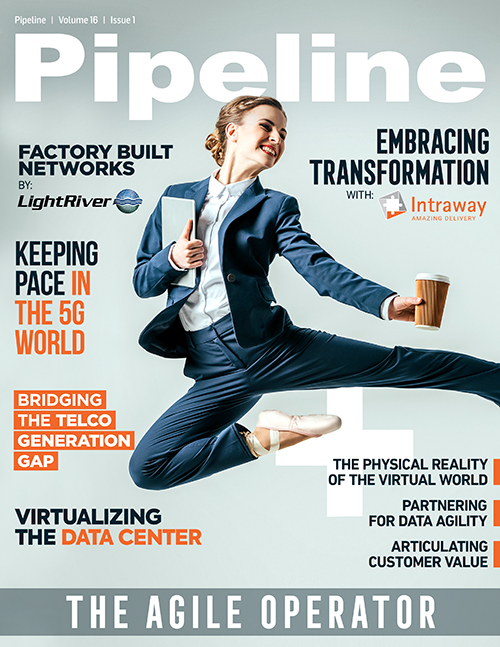Don't Fear Transformation, Embrace It
"...the driving force behind transformation in today's market — between whether you should take the leap or not — should be the fear of missing out."
Intraway is a leading provider of automation solutions and notable winner of Pipeline's annual Innovation Awards, an extensive evaluation of innovative products, companies and solutions. I
recently had the opportunity to interview the team from Intraway following their awards win, to gain more perspective. Over the last 15 years, Intraway has helped service providers in 22
countries digitally transform in record time, leverage the latest technologies, and capitalize on emerging market opportunities.
To do this, Intraway ensures minimal operational disruption by including over 50 network adapters and support for cloud, container, microservice, virtual and hybrid architectures off the shelf.
The company's Symphonica product also ensures interoperability with its standards-based design and open API framework. Symphonica is a flexible
orchestration engine that manages complex orchestration processes, supporting high-volume transactions efficiently with zero-touch service order management. Essentially, Symphonica simplifies the
management of existing services and increases service providers' agility to deploy new services. These are new services which just happen to be in the high-growth areas in which you probably want
to be.
And there are significant growth opportunities at different stages of maturity in our industry today. The IoT, or Internet of Things, has been around for a while starting with machine-to-machine
(M2M) offerings years ago. But the explosive growth in IoT has only just begun, with billions of connected devices coming online across enterprise, industrial, and residential segments. The next
evolution of wireless services, 5G, is just getting started. Wireless spectrum has been acquired and limited production deployments have been successfully completed, laying the foundation for a
plethora of new use cases and market opportunities. But capitalizing on these opportunities won't be easy. And easy is the name of the game.
It's also important to note today's high-growth, trillion-dollar market capitalization, and that mega-profit companies have it easy. Maybe not in the traditional sense of the word, but the
new digital economy is built on a foundation where the company provides and maintains a platform, and the customer does the work with it.
Looking at it another way, when was the last time you called Google? When was the last time you used Google's services? If you're reading this article, you may have used them to get here.
When was the last time you talked to someone at Amazon? On the other hand, when was the last time you bought something or used one of Amazon's platforms? Netflix? Microsoft? Apple?
When did any of these company do anything for you other than offer their platform to you? The simple fact of the matter is that the new digital economy is centered on a
build-and-expand platform experience backed by near real-time automation, hyper scalability and the very latest innovative technology. Or at least that is where the big money is.
Historically, complexity and cost multiply as new technologies, systems, and devices are added over time. This legacy approach is unsustainable in high-growth areas, and service providers
need a platform that helps them bridge the old and new. Intraway does this by taking a bottom-up approach at service fulfillment, eliminating manual tasks and adding automation to streamline
operations. In a cable environment, this removes the proverbial swivel chair traditionally associated with multi-system, multi-device, and multi-network management. Intraway, though, goes a step
further by eliminating the need to pre-stage customer premise equipment (CPE), too. A field technician can install a CPE device on site by simply scanning a bar code and attaching it to a service
order, which then runs a predefined workflow to automate the configuration, provisioning, and testing of the device. This is in stark contrast to the legacy approach, where the device has to be
preconfigured and provisioned prior to a truck roll. This new approach solves a lot of real-world problems now but also lays a foundation on which cable service providers can transform from the
analog network of today to the digitally distributed architecture of tomorrow. It also allows the service provider to leverage multiple networks and technologies within the workflow to provide
high-demand services to their customers, such as HFC (Hybrid Fiber Coaxial) networks and GPON to offer increased bandwidth speeds.


















